Guess what? You can learn how to play any pop song on the piano with just three things: 1. Chords 2. Chord charts, and 3. Playing by ear.
In this article, we’ll run through these three things. Then we’ll connect you to more resources to fill in the gaps.
The awesome thing about pop songs is that you can play them as simple or as complex as you like. One song can sound stunning in five different ways, from the bare basics to Elton John-level virtuosity.
Table of Contents:
We love helping people learn the songs they love. Each week, we release quick tips, song tutorials, and other free content for piano players, by piano players. Subscribe to our mailing list so you don’t miss out. You can unsubscribe any time.
To learn how to play any pop song on the piano, you need to understand chords.
Why? Aren’t songs made of melodies and harmonies?
Well, yes, but if we break them down to their most basic components, all songs are built from chords. If you take sheet music — for example, “Someone You Loved” by Lewis Capaldi — you’ll discover that everything is built up of recognizable chords like D, A, and Bm.

After all, a guitar player who sings and plays can recreate an entire song by singing the melody over a small handful of chords.
And you can do the same thing with piano!
Now, some of you will want to play the melody of a song on your right hand and the chords on your left hand. Don’t worry — we’ll get to that soon 😉
> Suggested Lesson: How to Play ALL Piano Chords
You don’t need to know every single chord, or that much about chords to get started. If you’re a total beginner, start by memorizing these four chords: C, G, Am, and F.

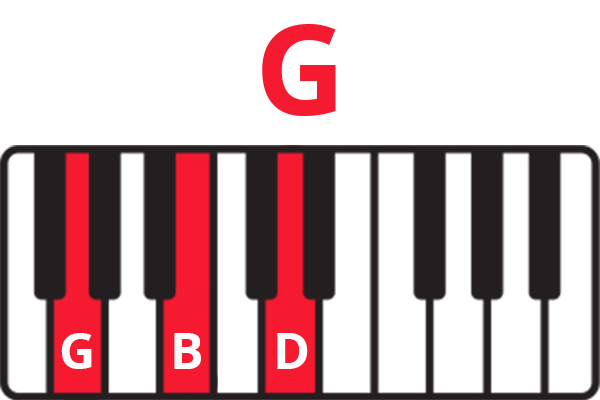

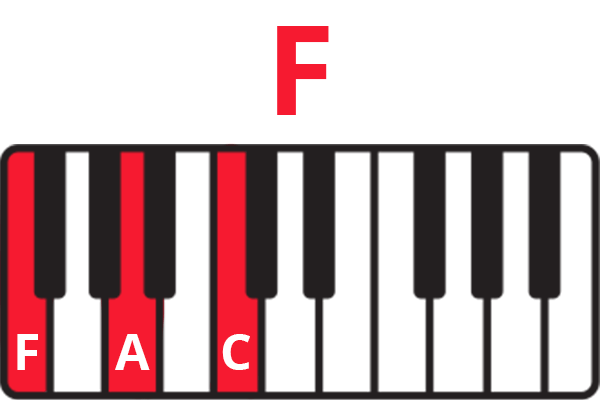
With just these chords, you can play basic versions of these songs:
Check out the tutorials linked above to get started and you’ll see what we mean when we say anyone can play songs on day 1.
At this point, you may be thinking: but chords are so boring!
Yes, playing triads in root position can quickly get cold. But once you’re comfortable with chord basics, there are countless little tweaks you can do to chords to make them sound more interesting, complex, and sophisticated.
Here are some ideas:
Chord inversions. “Inversion” is a fancy word for playing the notes of a chord in a different order. This will vary the sound a bit without changing the fundamental nature of the chord. You can find a chart of all inversions here.
Seventh chords. Seventh chords are responsible for that dreamy, jazzy sound you hear in piano music. In chord charts, they’re represented like “Cmaj7” and “Cm7.” Learn what these all mean here.
Sus chords and slash chords. If you’ve seen “Dsus4” and “G/B” on a chord chart and wondered what that was all about, learn about sus chords and slash chords. They’re easier than they look and they add more personality to your arrangements!
Remember: you don’t have to play chords in solid, quarter-note pulses all the time time. Break up your chords. Add some syncopation. Little things can make a big difference!
Okay, so you know how to play chords. But how do you know what chords to play if, say, you want to play “Falling” by Harry Styles?
Easy: use the internet!
We’re living in a wonderful time because we can find resources, with the click of a button, on how to play almost any pop song on the piano. You can find the chord charts (instructions on what chords a song has and when to play them) for most popular songs on Ultimate-Guitar.com.
Nope, this website isn’t just for guitarists. You can toggle the chord diagrams at the top of the page to “piano” and it’ll tell you exactly what keys to play for certain chords.
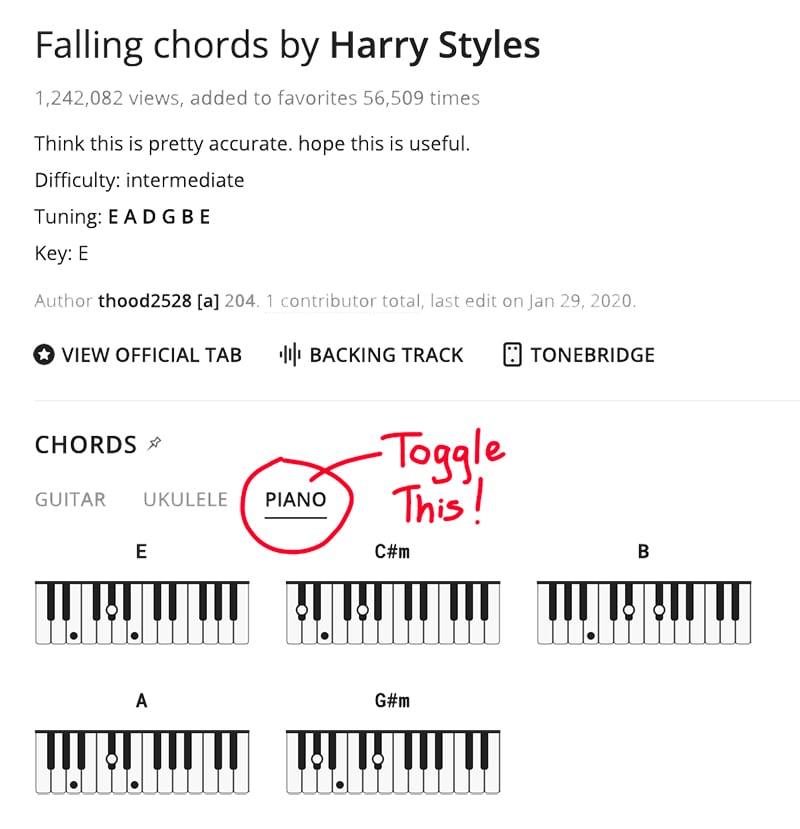
If you’re new to chord charts, they’re pretty easy to decipher. The chord symbols are placed above the lyrics of a song, which means you change chords whenever a new chord appears above a lyric.
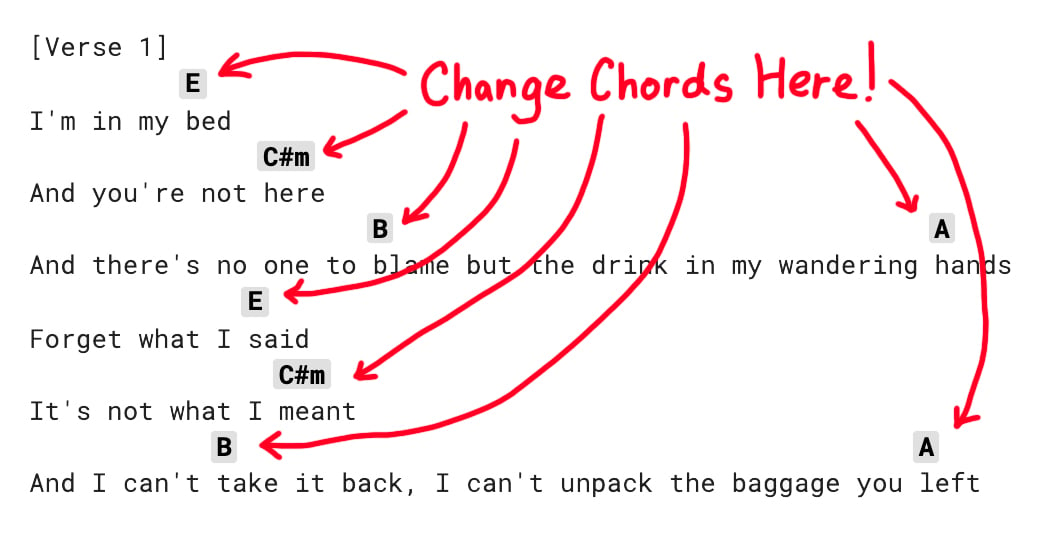
Now, not all chord charts are accurate. Many free chord charts you’ll find on the internet are created by amateur musicians who share and upload their transcriptions for free. Sheet music and chord charts by the original musicians are often copyrighted and will cost money.
So if something sounds wrong to you, you may be right. This is why knowing how to play by ear is such an important skill even when you have tools like chord charts. We’ll explore this in a bit!
Lead sheets are somewhere between chord charts and full-on sheet music. They include the notes for the melody of a song along with chord symbols and they’re ideal for beginner sight-readers because they’re less intimidating to read than a grand staff.
Learn more about lead sheets here. And if you’re new to reading music, make sure to check out our most popular tutorial on YouTube, “How to Read Notes.”
You can also download lead sheets on sites like 8notes, Musescore, and SheetMusicDirect.
As a Pianote+ Member, you’ll get access to our 10-step Method, song library, and growing community of piano players just like you. Plus: get coached by world-class pianists who have played with rock stars.
Understanding chords gives you the foundation to start learning songs. But if you prefer playing your melody instead of singing it, or if you can’t find chord charts for a song, you’ll need to know how to play by ear.
Being able to hear something and then play it on an instrument is a fantastic skill. Indeed, some of the world’s most famous musicians didn’t use sheet music. The Beatles couldn’t read sheet music and Mozart was rumored to recreate pieces by ear after listening to them once.
Playing by ear seems like a magical talent that only the best musicians have. But it’s a skill like any other. It can be learned and practiced.
A basic understanding of key will help you play songs by ear faster. The key can help you figure out the chord progression of a song.
In many pop songs, the key is the last note of the chorus. So if your song ends on E, it’s very likely that it’s in E Major.
Figuring this out is just trial and error. Here’s a demonstration in the beginning of this video:
Why is knowing the key useful? Well, if we know that a song is in E Major…
> Suggested Lesson: Ultimate Guide to Interval Ear Training
Intervals are a tool musicians use to help them play songs by ear. An interval is the space between two notes. If you can identify the intervals between notes, you can identify a melody.
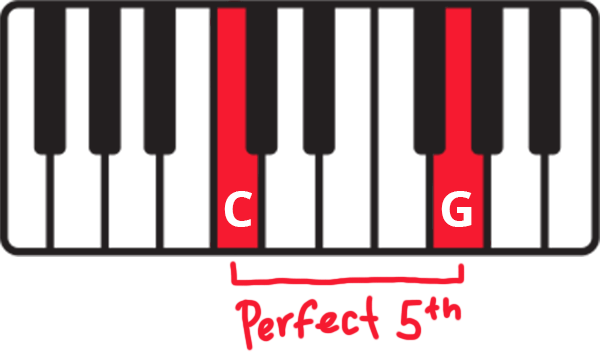
Each interval has a name and a distinct sound. You can recognize intervals by associating them with a song, such as:
Interval: Major 2nd (in C major: C to D)
Song: Happy Birthday
Interval: Major 3rd (C to E)
Songs: When the Saints Go Marching In, “Summertime” by George Gershwin
Interval: Perfect 4th (C to F)
Songs: Wedding March, We Wish You a Merry Christmas
Interval: Perfect 5th (C to G)
Songs: Twinkle Twinkle, Scarborough Fair
Interval: Major 6th (C to A)
Songs: My Bonnie Lies Over the Ocean, It Came Upon a Midnight Clear
Interval: Major 7th (C to B)
Song: “Don’t Know Why” by Norah Jones
Interval: Perfect Octave (C to C)
Song: “Somewhere Over the Rainbow” from The Wizard of Oz
Find more interval song shortcuts here.
While it may feel overwhelming at first, there are several ways you can practice recognizing intervals by ear:
Intervals can be used to figure out chord progressions too. When one chord moves to another, there’s a discernible interval between the sounds.
Learning to play by ear can be frustrating at first. It’s a trial-and-error process. But as we’ve mentioned before, it’s a skill like any other. It just takes practice!
Before long, you’ll be playing chords and melodies with ease.

Love more guides like this? Subscribe to The Note for more quick tips, cheat sheets, explainers, and other stuff piano players love. Delivered to your inbox for free.
You have learned that with three tools, you can play practically any pop song on the piano. Here’s a recap:
But! For an even bigger advantage, we have free, step-by-step, easy-to-follow tutorials right here on the Pianote blog. Beloved songs like:
These tutorials will give you an unfair head start in playing these songs!
And if you want to go even further, try 500 Songs in 5 Days. This pack includes bangers like:
Rocket Man
Elton John
No One
Alice Keys
Piano Man
Billy Joel
Photograph
Ed Sheeran
My Immortal
Evanescence
Hit the Road Jack
Ray Charles
Have fun learning songs and happy practicing!
As a Pianote+ Member, you’ll get access to our 10-step Method, song library, and growing community of piano players just like you. Plus: get coached by world-class pianists and learn whenever you want, wherever you want, and whatever you want.
TRY PIANOTE FOR 7 DAYSLisa Witt has been teaching piano for more than 20 years and in that time has helped hundreds of students learn to play the songs they love. Lisa received classical piano training through the Royal Conservatory of Music, but she has since embraced popular music and playing by ear in order to accompany herself and others. Learn more about Lisa.


By signing up you’ll also receive our ongoing free lessons and special offers. Don’t worry, we value your privacy and you can unsubscribe at any time.
We use cookies for traffic data and advertising. Cookie Policy »